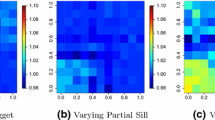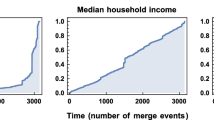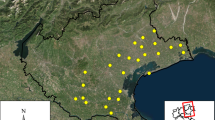Abstract
In this research, we propose a novel technique for visualizing nonstationarity in geostatistics, particularly when confronted with a single realization of data at irregularly spaced locations. Our method hinges on formulating a statistic that tracks a stable microergodic parameter of the exponential covariance function, allowing us to address the intricate challenges of nonstationary processes that lack repeated measurements. We implement the fused lasso technique to elucidate nonstationary patterns at various resolutions. For prediction purposes, we segment the spatial domain into stationary sub-regions via Voronoi tessellations. Additionally, we devise a robust test for stationarity based on contrasting the sample means of our proposed statistics between two selected Voronoi subregions. The effectiveness of our method is demonstrated through simulation studies and its application to a precipitation dataset in Colorado. Supplementary materials accompanying this paper appear online.







Similar content being viewed by others
References
Anselin L (1995) Local indicators of spatial association-LISA. Geogr Anal 27:93–115
Bandyopadhyay S, Rao SS (2017) A test for stationarity for irregularly spaced spatial data. J R Stat Soc Ser B 79:95–123
Cressie N, Hawkins DM (1980) Robust estimation of the variogram: I. Math Geol 12:115–125
Fuentes M (2005) A formal test for non-stationarity of spatial stochastic processes. J Multivar Anal 96:30–54
Guinness J, Fuentes M (2015) Likelihood approximations for big nonstationary spatial temporal lattice data. Stat Sin 25:329–349
Jun M, Genton M (2012) A test for stationarity of spatio-temporal random fields on planar and spherical domains. Stat Sin 22:1737–1764
Matérn B (1986) Spatial variation, 2nd edn. Springer-Verlag, Berlin
Muyskens A, Guinness J, Fuentes M (2022) Partition-based nonstationary covariance estimation using the stochastic score approximation. J Comput Graph Stat 31:1025–1036
Paciorek CJ, Schervish MJ (2006) Spatial modelling using a new class of nonstationary covariance functions. Environmetrics 17:483–506
Qadir GA, Sun Y, Kurtek S (2021) Estimation of spatial deformation for nonstationary processes via variogram alignment. Technometrics 63:548–561
Rand WM (1971) Objective criteria for the evaluation of clustering methods. J Am Stat Assoc 66:846–850
Schwarz G (1978) Estimating the dimension of a model. Ann Stat 6:461–464
Tibshirani R, Saunders M, Rosset S, Zhu J, Knight K (2005) Sparsity and smoothness via the fused lasso. J Roy Stat Soc B 67:91–108
Voronoi G (1908) Nouvelles applications des paramètres continus à la théorie des formes quadratiques. Premier mémoire. Sur quelques propriétés des formes quadratiques positives parfaites. J Für die reine Angewandte Mathematik (Crelles Journal) 1908:97–102
Zhang H (2004) Inconsistent estimation and asymptotically equal interpolations in model-based geostatistics. J Am Stat Assoc 99:250–261
Acknowledgements
Hsin-Cheng Huang’s research was supported by Academia Sinica Investigator Award AS-IA-109-M05 and ROC National Science and Technology Council grant 111- 2118-M-001-011-MY3. ShengLi Tzeng’s research was supported by ROC National Science and Technology Council grant 110-2628-M-110-001-MY3. The authors have no conflict of interest to declare.
Author information
Authors and Affiliations
Corresponding author
Additional information
Publisher's Note
Springer Nature remains neutral with regard to jurisdictional claims in published maps and institutional affiliations.
Supplementary Information
Below is the link to the electronic supplementary material.
Rights and permissions
Springer Nature or its licensor (e.g. a society or other partner) holds exclusive rights to this article under a publishing agreement with the author(s) or other rightsholder(s); author self-archiving of the accepted manuscript version of this article is solely governed by the terms of such publishing agreement and applicable law.
About this article
Cite this article
Tzeng, S., Chen, BY. & Huang, HC. Assessing Spatial Stationarity and Segmenting Spatial Processes into Stationary Components. JABES 29, 301–319 (2024). https://doi.org/10.1007/s13253-023-00588-5
Received:
Revised:
Accepted:
Published:
Issue Date:
DOI: https://doi.org/10.1007/s13253-023-00588-5








